Menu
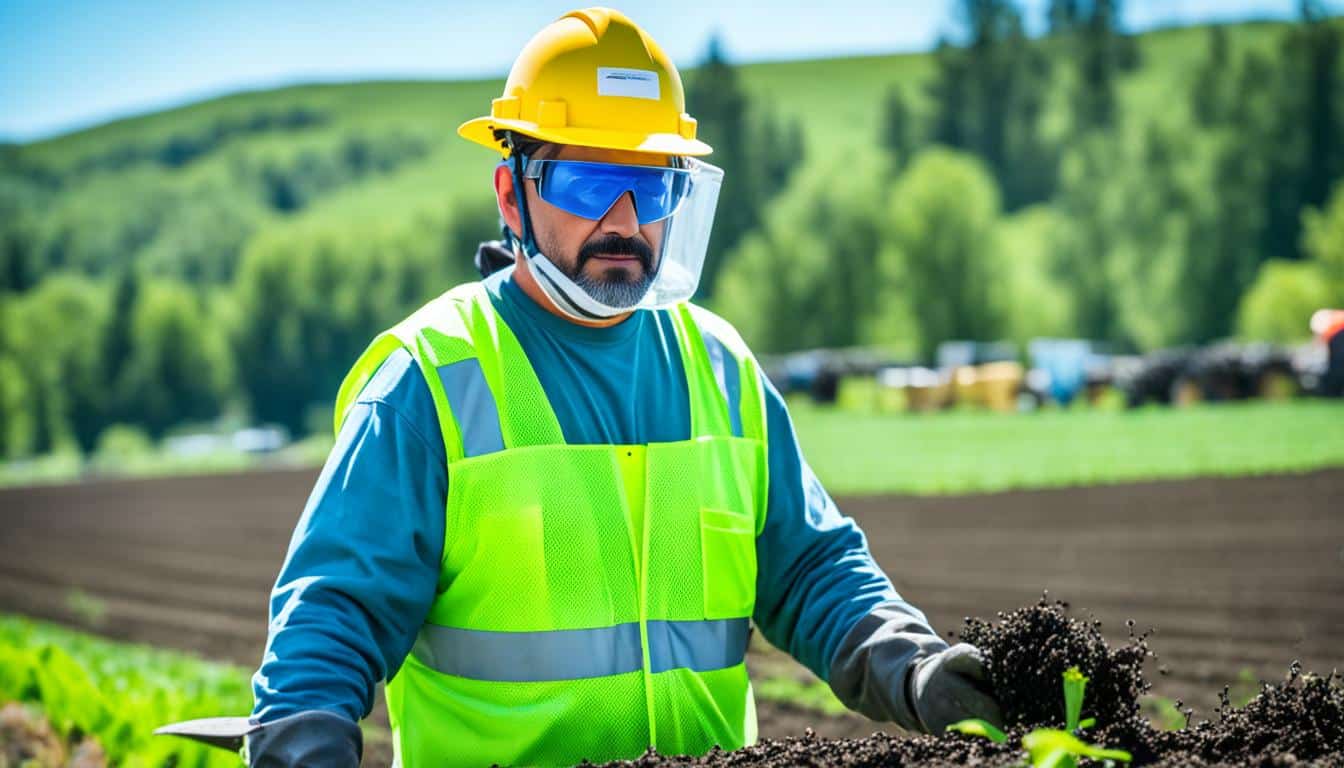
Is poor communication putting farmworkers at risk? This is a key question. When I looked into safety communication in farming, I found alarming facts. The CDC says around 100 farmworkers face injuries that stop them working every day in the U.S. Many of these injuries come from simple things like not drinking enough water or not understanding work-safety rules. This makes us wonder – could better communication stop these accidents?
Injury prevention isn’t the only issue. Bad communication also leads to a lot of people leaving their jobs at Napa Valley vineyards, a study found. On the other hand, businesses that communicate well, like Good Farms, have many benefits. They save on costs, keep staff happy, and most crucially, prevent injuries and save lives.
Communication is key on farms to prevent accidents and save lives. It helps with issues like not drinking enough water, working too long without a break, and not knowing how dangerous some tasks are. Better communication keeps everyone safe, works better, and makes people want to stay in their jobs.
Talking well at the farm stops many accidents. The CDC says 100 farmworkers get hurt so badly they can’t work each day in the United States. But, if employers share clear safety rules, people know how to avoid dangers. This makes the farm safer and saves money that would have been spent on these injuries.
Clear and regular talks make farm workers pay more attention to safety. In Napa Valley, bad communication makes workers leave their jobs. By checking with workers every day and teaching them in languages they understand, the gap is filled. This way, everyone knows what to do to stay safe.
Good communication affects the entire farm business. In California, talking right helped keep workers in their jobs even when there weren’t enough of them. Good Farms is an example. They stop many workers from leaving by focusing on safety talks. Studies also show that better communication makes everyone aware of hazards, especially women who are at more risk.
| Key Statistics | Data |
|---|---|
| Daily Lost-Work-Time Injuries (CDC) | 100 farmworkers |
| Primary Reason for Turnover (Napa Valley) | Poor communication |
| COVID-19 Impact | Significant losses |
| Essential Communication in Labour Shortages | Worker retention |
Understanding farmworkers’ needs is key to keeping them safe in agriculture. It’s vital to tackle the hurdles in safety communication. These include not just language, but also culture and literacy issues.
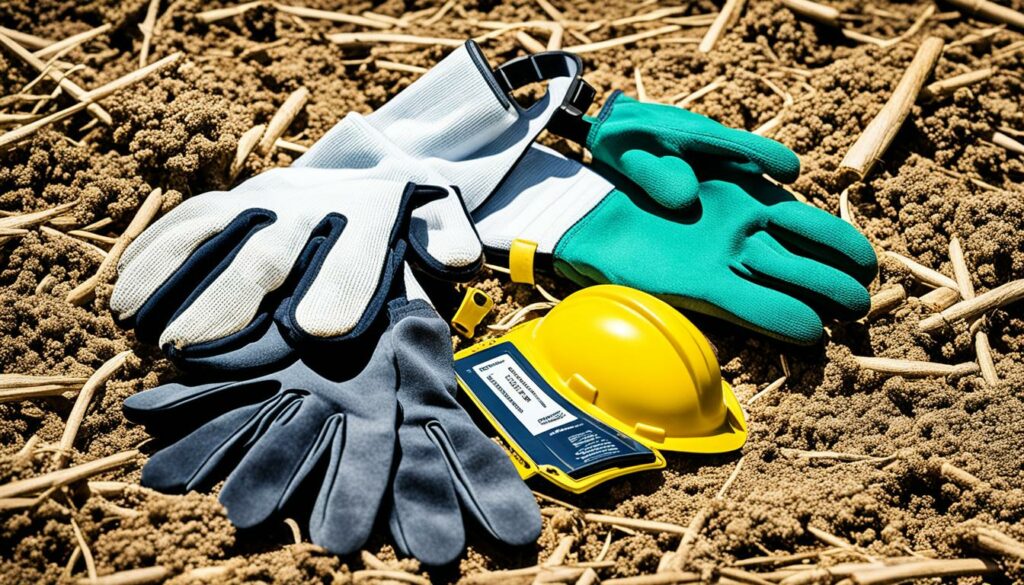
Farmworkers often speak languages different from English. This makes sharing safety practices hard. We must offer materials in their own languages. This includes translating guides and using pictures.
For example, Ontario’s OHCOW suggests using translated guides and images. These ensure all workers get crucial safety information.
Cultural context also affects how safety messages are understood. A 2021 study from Murray State University shows how cultural differences can risk the safety of female workers in male-dominated farms.
Knowing and respecting different cultures helps tailor safety efforts. This makes the workplace safer and more welcoming for all.
Some farmworkers might struggle to read. This makes written safety guides less helpful. Using pictures and hands-on methods can help. They fill the gap for those with less reading skills.
Surveys in the workers’ languages, like Spanish, are useful. They help learn about specific needs. This way, safety plans can be made personal and more effective.
Insights from the WCAHS are crucial. For over 30 years, they’ve focused on helping in agriculture. Programs like the COVID-19 SAFE show how effective communication can make a big difference in safety.
| Challenges | Solutions | Results |
|---|---|---|
| Language Barriers | Provide translated materials; use visual aids | Enhanced comprehension of safety protocols |
| Cultural Considerations | Respect cultural norms; address specific vulnerabilities | Improved workplace respect and security |
| Literacy Levels | Use participative communication; conduct surveys | Better engagement and tailored safety interventions |
Technology is changing how we deal with safety and talk to each other in farming. Since farming is risky—with chances of dying up to 30.6 in 100,000—it’s crucial we use tech to keep us safe and communicate well.
Text messages are quick and clear ways to talk to farmworkers. They’re great for urgent messages like danger warnings. Plus, many older farmers have hearing problems, so texting makes sure they get these important messages.
Only 1% of the UK’s workers are in farming, yet they face 20% of work deaths. Auto-translation tech helps by breaking language barriers. For example, Ganaz uses this to explain safety steps in real-time, no matter what language a worker speaks.
Apps for farm safety are more and more important. They offer training, keep you updated on safety, and can even check noise levels. These apps watch the data to predict dangers, helping stop accidents before they happen. They can also warn about gas or fires quickly.
GPS is crucial for fast help in emergencies. It finds people within a few meters accurately. Apps like what3words make it even better by giving every spot on earth a unique address, helping emergency services reach you faster.
Devices like smartwatches can save lives too. They keep an eye on the health of workers and the air they breathe, stopping heat illnesses and too much hard work.
Using new tech is essential for farming to be safer. From apps to analytics, these tools are key in reducing risks and improving life for those who work the land.
| Innovation | Benefit |
|---|---|
| Text Messaging Tools | Immediate, accessible safety communication |
| Auto-Translating Software | Breaks language barriers, enhancing message clarity |
| Mobile Applications | Comprehensive safety training and real-time hazard updates |
| Wearable Devices | Monitors vital signs to prevent health-related incidents |
| Predictive Analytics | Forecasts risks to prevent accidents |
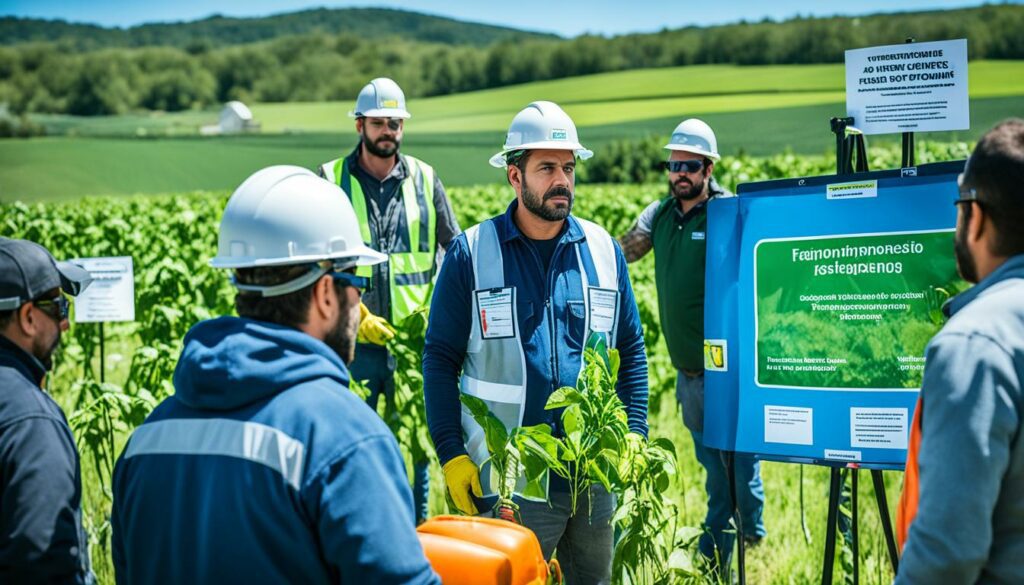
Training programmes are key for boosting farmworker safety. They teach important things and help workers stay alert while working. One well-known way to do this is the tailgate safety training. In this method, workers get quick, to-the-point lessons right where they work. This is essential for lowering risks.
After 36 years working in farm safety, I’ve seen how powerful tailgate trainings are. They help in farms growing corn and soybeans, apples, and dairy. These are most effective with 5 to 10 workers and cover just one or two topics at a time. Keeping each session under 15 minutes makes sure the information sticks.
Studies from UW–Madison show that workers like these trainings. They feel valued and get involved. It’s also best to do these early in the week. This helps start each work week with a focus on safety.
| Industry | Group Size (Effective) | Session Duration |
|---|---|---|
| Corn and Soybean Producers | 5-10 employees | 15 mins |
| Apple Growers | 5-10 employees | 15 mins |
| Dairy Farmers | 5-10 employees | 15 mins |
It’s important to keep reminding workers about safety. I suggest having meetings every week or two to go over agricultural safety protocols. These meetings help turn safety rules into habits, thus reducing accidents. It’s also good to talk about what went wrong recently, so everyone learns from mistakes.
Visually appealing handouts are great for these meetings. They include pictures and use less text. This way, everyone can understand, no matter their reading level. This helps make the information stick, which means fewer accidents.
The AFOP Health & Safety National Farmworker Training Program is leading in safe training. They use many languages and interactive methods to teach. With materials in English and Spanish, plus other languages like Haitian-Creole and Mixteco, they ensure everyone can learn safely.
To wrap up, good training programmes are key to making farms safer. By mixing hands-on tailgate sessions with regular safety talks, injuries can be reduced. This shows farm bosses care about their workers’ safety. And that’s crucial for a safer workplace for everyone.
The farm world is full of dangers, so ensuring farmworker safety communication is key. We must teach workers about risks and make sure they follow safety rules. It’s vital to prevent farm accidents through proper communication.
As the climate warms, heat illnesses pose a bigger threat to farm staff. From cramps to heat stroke, these can be deadly. Teach workers to acclimatise and follow “Water, Rest, Shade” rules. Regular training and clear communication on spotting heat stress and what to do are essential.
Farmworkers often deal with chemicals that can be harmful if not handled correctly. Proper communication for farm accident prevention is crucial. It teaches the right ways to use, store, and get rid of harmful substances. Wearing protective gear, closely following safety steps, and getting trained in chemical safety cuts down on injuries and sickness.
Farm equipment, whether big machines or small tools, brings many risks. The key is to use them correctly, backed by clear safety instructions. Stressing regular maintenance, correct use, and safety in equipment use through clear farmworker safety communication is critical. It helps avoid serious harm. Deaths and injuries can often be traced back to equipment misuse. This shows the huge importance of safety rules.
Strong, focused safety communication can do wonders for farm safety. It protects workers and boosts the farm’s success and sustainability.
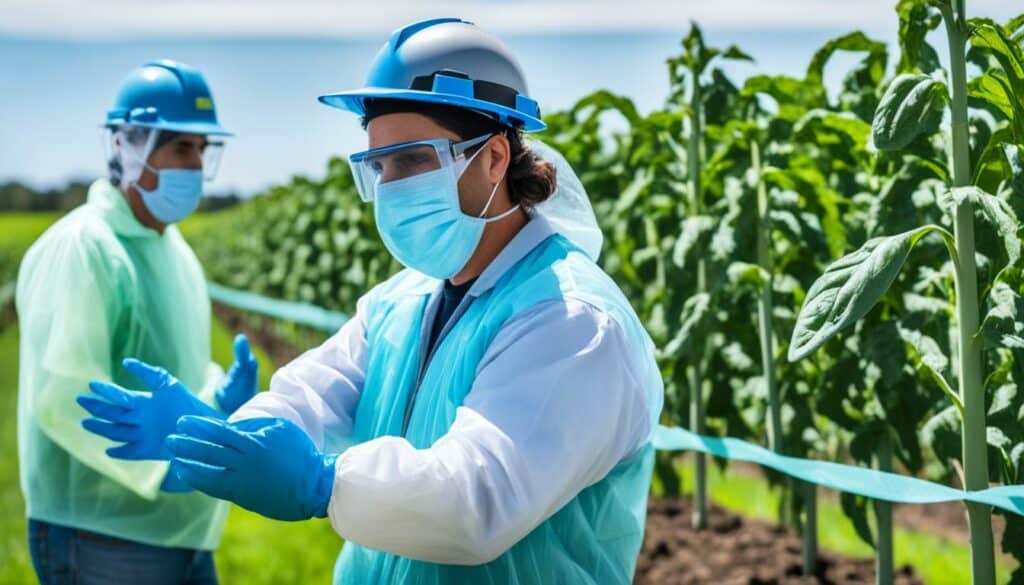
Making sure farmworkers know how to stay safe is key. It’s not just about sharing information; they must also understand and use it. Every day, about 100 farmworkers in the U.S. get hurt and miss work. Effective safety messages are really important.
In Napa Valley, vineyard workers often left their jobs because of poor communication. They worried about long rides to work, getting sick from the heat, and not being told when pesticides were being sprayed. Tools like the ones from Ganaz platform help keep workers happy by sharing job info, pay, benefits, and events.
During COVID-19, clear safety messages saved workers at Good Farms and AgSocio. Not being trained or informed well enough leads to more accidents and deaths on farms. So, keeping safety messages strong and clear is a big deal in keeping workers safe.
To stop sexual harassment and get everyone more involved, tools like Ganaz’s can really help. They break down language barriers and make communication smoother. Doing surveys in Spanish using these tools can help find out what workers really think without them feeling scared. These surveys can touch on job happiness, understanding of training, why workers leave, and how they feel overall. This can make farmworker safety communication much better.
Keeping farmworkers ready for emergencies needs careful planning and clear communication. They should be ready for all kinds of emergencies, from natural disasters to man-made crises. By improving how we talk about safety, we make sure help comes fast.
Farmworkers need to know who to call in an emergency. Employers should give them a list of important numbers. This list should include emergency services and other vital help contacts. It’s crucial that everyone knows how to find this list quickly.
It’s important that farmworkers understand the signs of heat stroke and how to react. This is especially true in summer when the risk is high. They should know what to do and the importance of keeping hydrated. This knowledge helps keep them healthy and working well.
Practising with mock drills is key for preparing farmworkers for emergencies. These drills cover actions like how to evacuate and what to do when an alarm sounds. By practising these scenarios, they become better at responding in real emergencies. Drills should be done at least once a year to keep their skills sharp.
Having a solid emergency plan and regular training is vital for a safe farm. Making sure farmworkers understand safety helps lower risks. This way, they are ready for any emergency.
Getting farmworkers involved in talking about safety is key to a safe farm. We need to talk to them well so they know we listen and they matter. This helps make the farm a safer place.
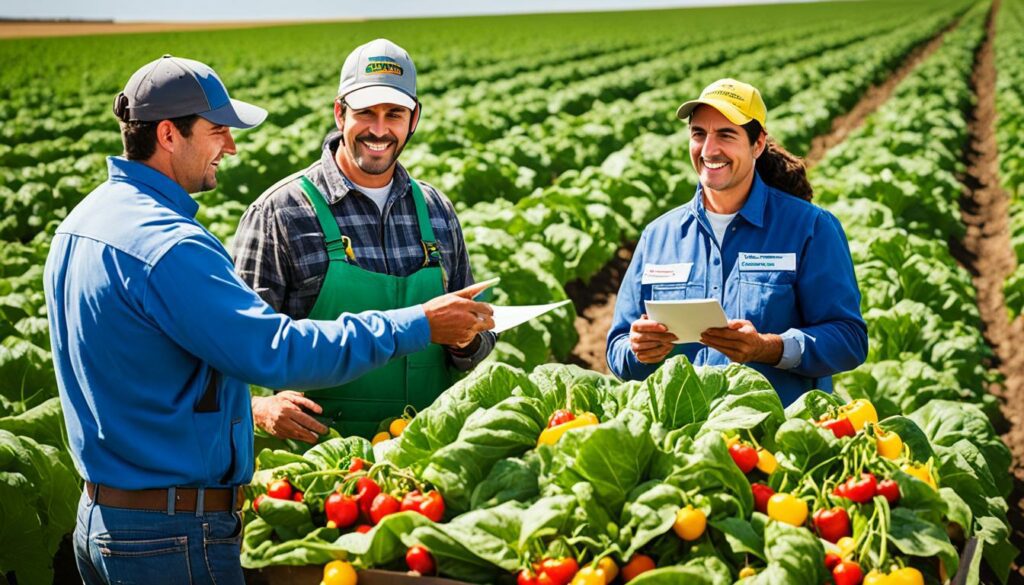
Good ways to get feedback on farm safety are very important. Having a way for workers to talk without giving their names can be really helpful. It lets bosses know what’s really going on without anyone being scared. This makes farm work a better place to be and builds trust.
Asking questions that need more than a ‘yes’ or ‘no’ helps workers open up. They can talk about their experiences and give ideas. This helps everyone understand safety better at the farm. Workers feel more involved and safe when they can freely share their thoughts.
Doing regular surveys with well-thought-out questions can be a big help. They show what needs to be safer at the farm. Research, like that by Caffaro et al., proves that training really helps farmworkers. Following these studies improves how we talk about and handle safety at the farm.
Studies by Narasimhan et al. points out that following safety rules cuts down on accidents. Surveys help find gaps in safety efforts and suggest how to fix them. This helps keep the farm a safer place and communication about safety more open and effective.
Using pictures and symbols can greatly help on farms. They make sure everyone, no matter their language, understands how to be safe. As almost half of the world’s workers are in agriculture, these clear visuals are very important.
Pictures and symbols make farm safety rules easy to grasp, especially for those who can’t read well. They let workers know about dangers and remind them to be safe. This is all without needing lots of words.
Visual aids are key in teaching farm safety. They help make training more effective. Studies show that adding pictures and signs makes safety messages clearer. This is very important for people who might not understand written information well.
In Ontario, they lead by example. They use pictures to make sure everyone gets the safety message. This way, people don’t just read safety rules – they understand and remember them too. This approach makes farms safer for everyone.
Sexual harassment in farming is a big and sad problem. Women who work on farms often face harassment more than those in other jobs. Using good ways to talk is crucial to stop this. The Washington Coalition to Eliminate Farmworker Sexual Harassment, started in November 2017, joins with many groups. They aim to make farms safer places to work by sharing important tips and tools.
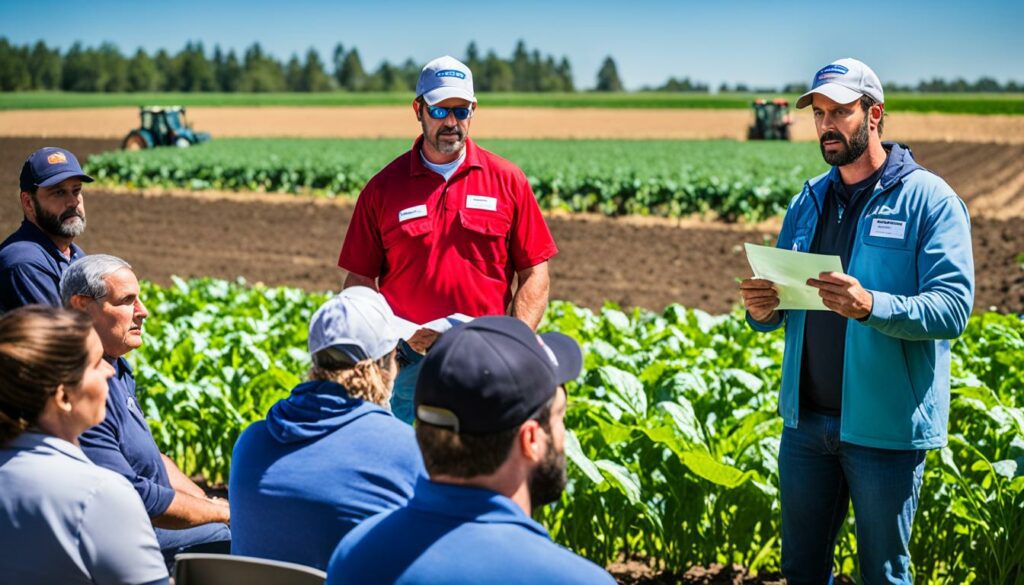
Not being able to talk in the same language stops some farmworkers from speaking up. Technology that can translate messages helps break this barrier. It lets non-English-speaking workers safely report what’s happening. This makes it easier to deal with harassment on farms by opening up ways for everyone to share their concerns.
Protecting one’s identity when making a report is very important. Many workers are afraid of what might happen if they report bad behaviours. But, with systems that keep their details secret, they can tell their story without being scared. This helps tackle the harassment issue more openly and quickly. The work of groups like the Washington Coalition helps too, by pushing for better laws and more knowledge.
Teaching supervisors well is key to having a safe farm. They need to know what to do when someone reports harassment. This includes spotting the warning signs, knowing what the farm must do, and how to help. PNASH provides lots of useful lessons for supervisors, making sure they’re ready to keep the workplace respectful and secure.
| Key Strategies | Details |
|---|---|
| Auto-Translating Messaging Tools | Bridges language barriers, ensures accurate translation of complaints. |
| Anonymity in Reporting | Secure systems to encourage reporting without fear of retaliation. |
| Training for Supervisors | Equips supervisors with skills to effectively address harassment. |
By using such plans, we can do a lot to stop harassment on farms. Working this way makes farm life safer and more respectful for everyone.
Creating a strong culture of safety in agriculture is vital. It helps in making the workplace safer and reducing accidents. In Vermont, efforts to improve safety have gotten a big boost. The Northeast Dairy Business Innovation Centre gave $350,000 for safety training. This will help dairy farmers learn how to keep safe. The training is available in both English and Spanish to help everyone.
A good culture of safety in agriculture starts by talking openly. Many farmers use off-farm translators and hand signals to communicate. But, it’s not always enough. New safety training programs are being made to meet each farm’s unique needs. They aim to make training clear and easy to understand.
It’s important to praise and reward safe work. When bosses recognise safe practices, it shows they care. It also makes workers feel good about what they do. This positive feedback can help reduce stress. It also makes workers pay more attention to safety.
Sticking to the farmworker safety communication rules is key. Vermont is updating its safety training to share tips regularly. This keeps the focus on safety. Making sure everyone understands the safety rules helps keep the workplace safe.
| Statistic | Data |
|---|---|
| Grant Amount for Safety Training | $350,000 |
| Yearly Wisconsin Farm Injuries | 12,000+ |
| Injury-Related Deaths in Wisconsin (2017-2018) | 75 |
| Medical Expenses for Farm Injuries (2021) | $3.2 billion |
| Per Capita Death Rate for Agricultural Workers | 7 times greater than other industries |
In agriculture, keeping farmworkers safe is crucial. The work of Good Farms and AgSocio shows how strong safety messages can make a difference. Their methods teach us the power of clear communication in cutting injuries and keeping workers happy.
Both Good Farms and AgSocio are praised for their safety efforts. They highlight how detailed safety communication saves lives and lessens work harm. Good Farms talks to workers often and uses pictures to show dangers. AgSocio mixes tech and face-to-face talks, making sure everyone understands by using language tools.
The Napa Valley vineyards show how important it is to communicate safety clearly. A study there found that setting clear rules and teaching often reduces accidents. By repeating safety messages, these vineyards made safety habits for their workers.
California’s farming industry has big wins in safety talks. In a 1996 survey, over 600 safety award winners shared how they cut down on injuries. They used things like videos and online tools. These stories prove how clever safety talk keeps workers safer.
When talking about farm safety, it’s vital to be clear and brief. Repeating safety information and using visuals are also key. These help everyone, even if English isn’t their first language.
Good communication cuts down on accidents and costs on farms. It makes sure everyone knows the dangers and how to stay safe. Workers learn to be careful, which stops accidents that can be expensive.
Getting workers interested in safety makes them watch out more. This helps them follow safety rules better, which means fewer accidents. It’s everyone working together to stay safe.
If safety is not well explained, workers might not stay. This could mean more accidents that are serious. It’s bad for the farm and the workers.
One way is by having materials in people’s own languages. Using pictures helps those who can’t read much. There are also tools that change text into different languages.
Knowing about different cultures means safety messages can work better. They help make sure everyone follows the safety rules. This brings more trust and better safety.
Show, don’t just tell. Use pictures, simple words, and actually show how to be safe. Talk with workers so everyone understands.
Texts, apps, and tools that change languages can make safety news easy to get. They make sure everyone stays informed and safe. Technology helps a lot.
These are quick, hands-on lessons about staying safe at work. They remind workers about important safety points. Learning happens right where they work.
Reminders keep safety fresh in everyone’s mind. They make sure workers stay careful. This helps stop accidents.
It’s important to talk about heat, chemicals, and machine safety. Each area should have clear safety tips and rules. This keeps everyone safer.
Good safety talk is about being clear and making sure people really get it. It means talking with workers and listening to them too. It’s a team effort.
Having emergency numbers, knowing how to help with heat illness, and practising what to do in emergencies are important. They prepare everyone for the worst.
Using surveys, open questions, and ways for workers to give feedback helps. It makes sure everyone can tell their safety concerns. This is key for keeping everyone safe.
Pictures help everyone understand, no matter the language. They make safety easy to grasp. This is key in keeping everyone on the same page about staying safe.
Talking openly and offering ways to report issues helps fight harassment. Training bosses also makes a big difference. Tools that translate mean everyone can understand what’s okay and what’s not.
It’s about talking about safety all the time, rewarding those who are safe, and keeping safety info consistent. This helps everyone know how important safety is.
Looking at successful farms shows the power of good safety talks. They teach us that clear safety messages can really lower accidents and keep the workers happy.